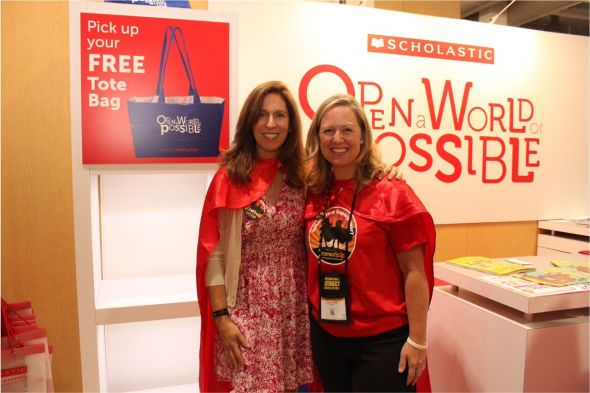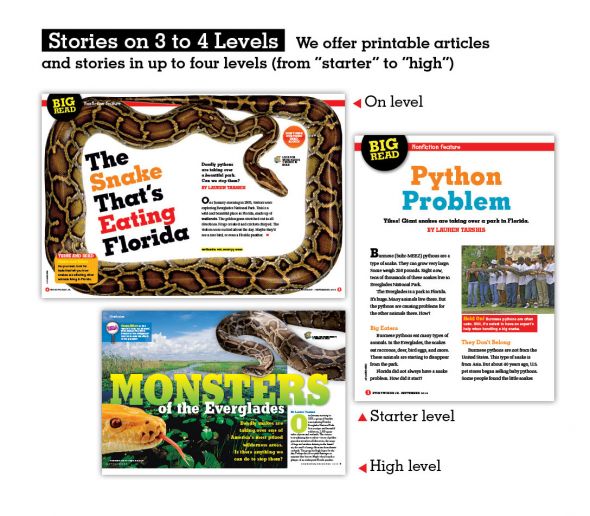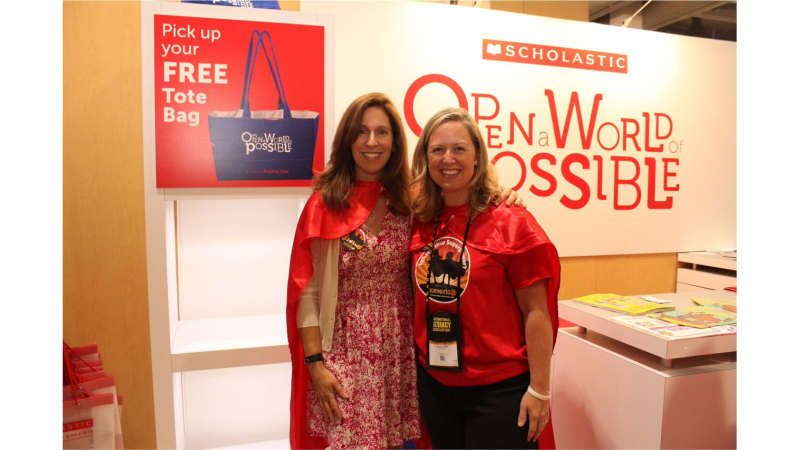Today we are joined by Kara Corridan, Executive Editor of Storyworks Jr.
Earlier this spring, we told you about Storyworks Jr., our brand-new ELA magazine just for third grade readers (and second graders who are reading at a high level). Now, as we move closer to the new school year, I want to give you a little update on what’s new and exciting with the magazine.
Things are heating up for us at Storyworks Jr.! We created a prototype issue this past winter, and field-tested it with teachers nationwide all spring. The feedback we got from educators informed everything you’ll see in our debut issue, which arrives in classrooms mid-August.
We’ve also been able to share it with some more of you over the past few weeks—at a Reading Summit in Leesburg, VA, as well as at ILA in Boston. Here I am with our fearless leader, Editorial Director Lauren Tarshis, wearing the capes we gave out to you, our “superhero” teachers at our Storyworks Jr. ILA launch party:

The early response to Storyworks Jr. is incredibly encouraging. Young students love the magazine format and riveting stories, and teachers love the natural tie-ins to science and social studies topics. Teachers are telling us how grateful they are for our variety of formats—we’ve got amazing and important knowledge-building nonfiction stories, plus short fiction, read-aloud plays, poetry, paired texts, debate and infographics.
We also have columns that focus on vocabulary (Storyworks Jr. emphasizes domain-specific and academic vocab), grammar, and paragraph writing. Of course, this is all in addition to the dozens of activity sheets and quizzes we provide with each issue that will help growing readers develop comprehension, analytical reading skills and test-readiness.
I also want to bring your attention to one important note that is a special aspect of Storyworks Jr.: our content and resources increase in complexity throughout the school year. (You can read more about that here!)
And this kind of attention to students’ learning progression brings me to the one key word guiding us as we create Storyworks Jr.: differentiation. We know how many of you have readers who are on several levels, and it’s critical that our content is accessible to all of them. We’ve been working overtime to ensure that we have truly powerful tools for differentiation. For example, in the case of our main narrative nonfiction feature, we’ll offer up to four levels:
- the on-level version
- the lower-Lexile version
- the higher-level version, which is the story that originally appeared in Storyworks (the resource for 4th and 5th graders)
- a “starter” version, which is a linear and straightforward presentation of the most basic facts, plus vocabulary

We also offer plenty of audio versions of our articles, because we know how engaging audio is for all students, and what a useful intervention tool it is for ELL students and struggling readers.
But if you’ll indulge our pride for a moment, the pièce de résistance in our differentiation toolkit is our Video Read-Aloud. Think of it as everything that’s great about video combined with everything’s that’s great about audio. As you’ll see from this clip, Lauren Tarshis narrates her narrative nonfiction about Mount St. Helens, while authentic footage and photos complement the text. It offers background information, and aids fluency and comprehension. And talk about engagement: Teachers who’ve used it have all said it’s a game-changer. (Learn even more about differentiating instruction with the Video Read-Aloud here!)
We are beyond excited to know what you think of Storyworks Jr.. And to prove it, we’re offering online resources for free at storyworksjr.scholastic.com. We hope you’ll sample it with your grade 2 and 3 classrooms.
And we’ll be eager to hear about your experience:
- Does the content grab your kids? (Upcoming topics include: snakes taking over the Everglades, a comparison of early explorers and space explorers, whether trampolines should be banned, and a vicious blizzard that affected hundreds of schoolchildren in 1888.)
- Do our activities address the key skills your students need to practice?
- What other writing supports do you need for transitional readers?
Please tell us! I hope I’ve enticed you to check out our debut issue.
Let’s keep in touch this year. Please email me at kcorridan@scholastic.com. In the meantime, I’m wishing you restful and restorative last days of summer, and here’s to a fantastic school year!



